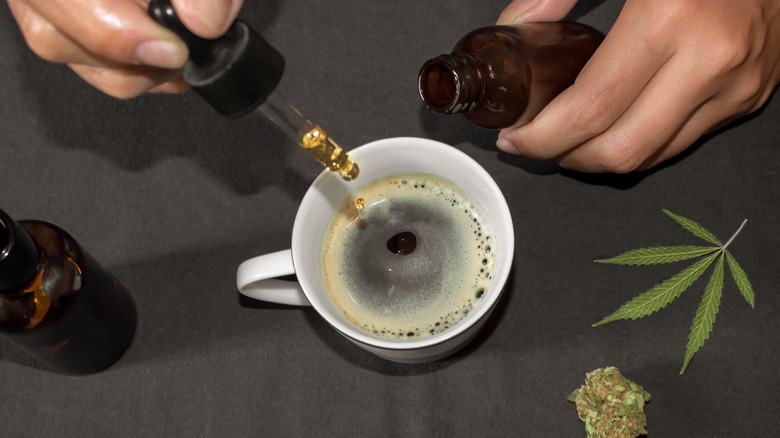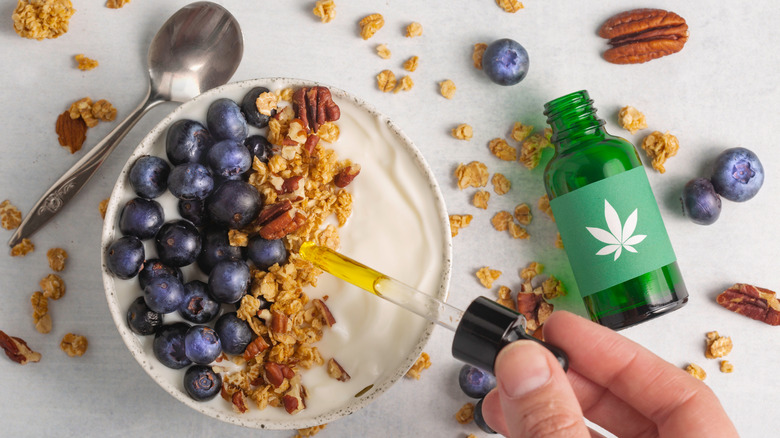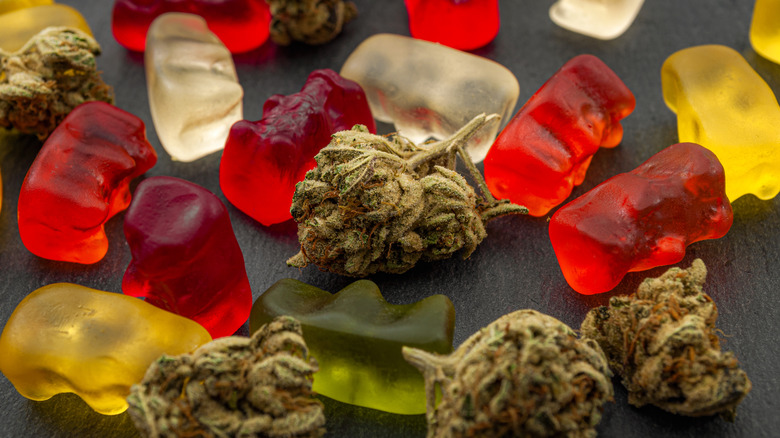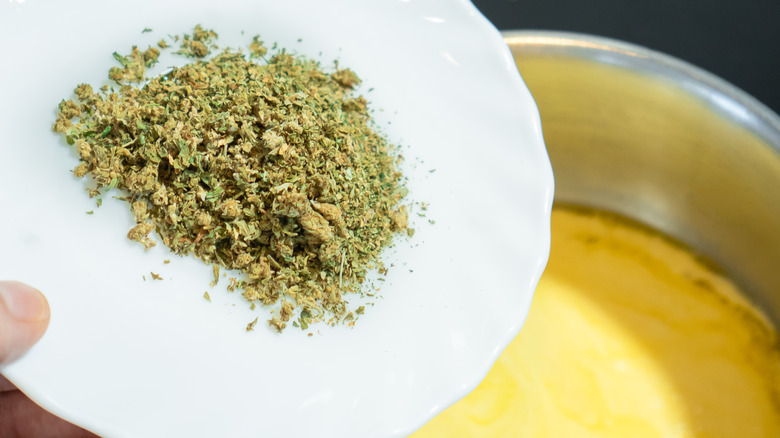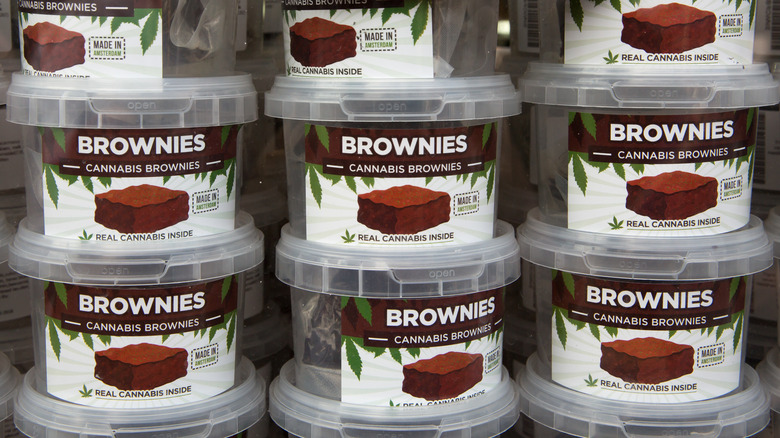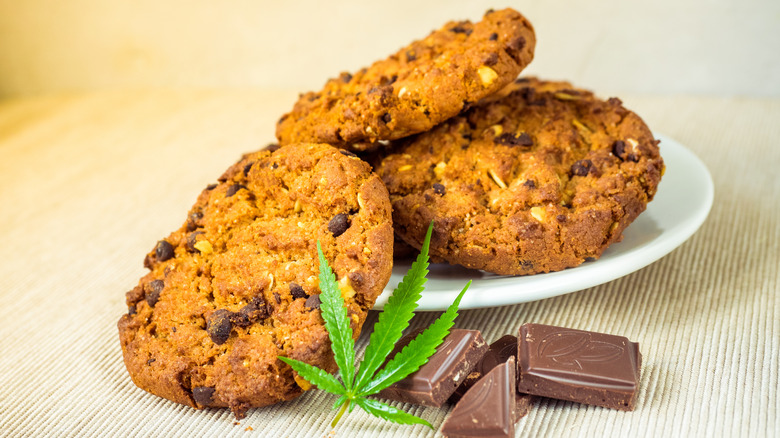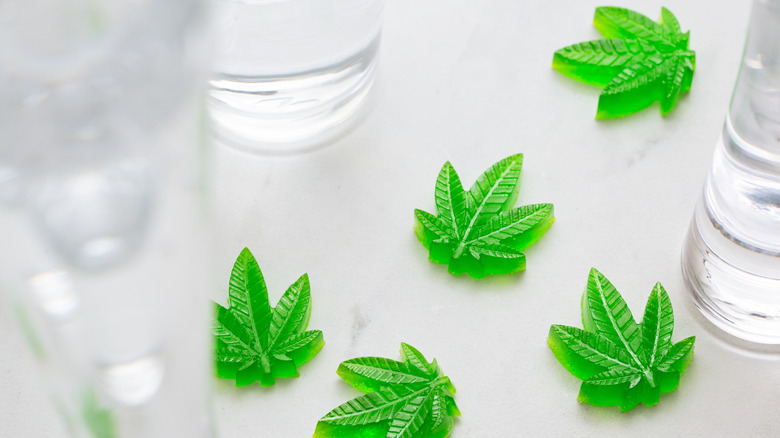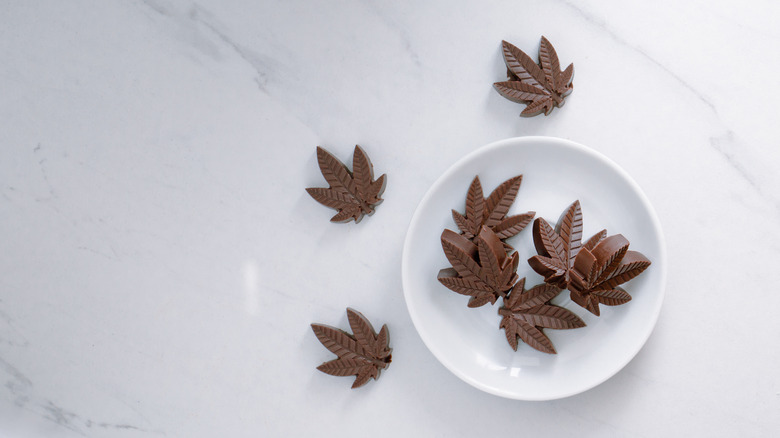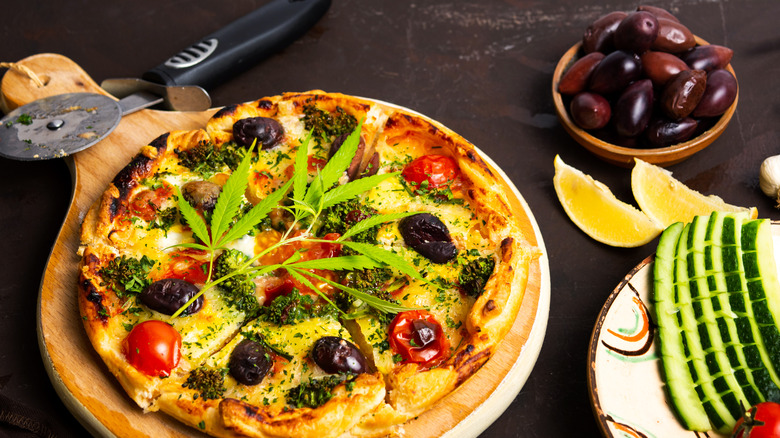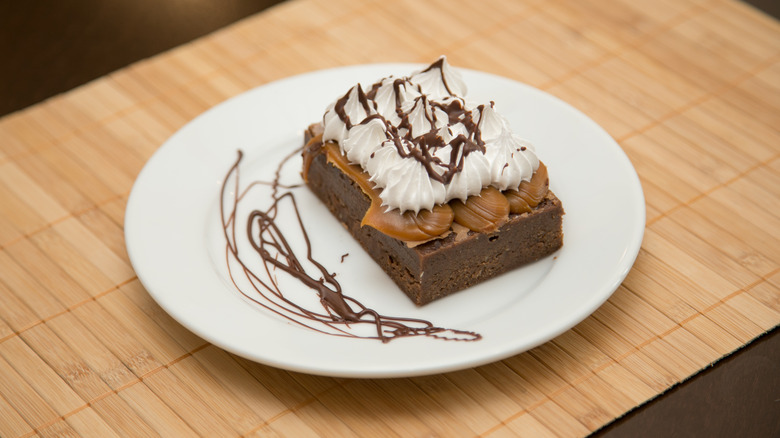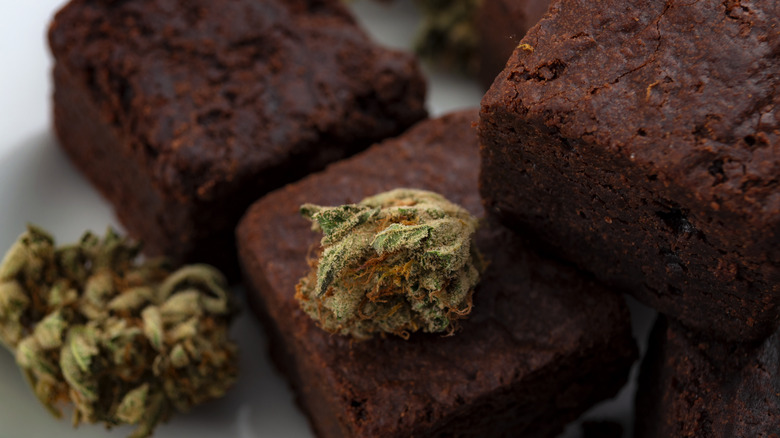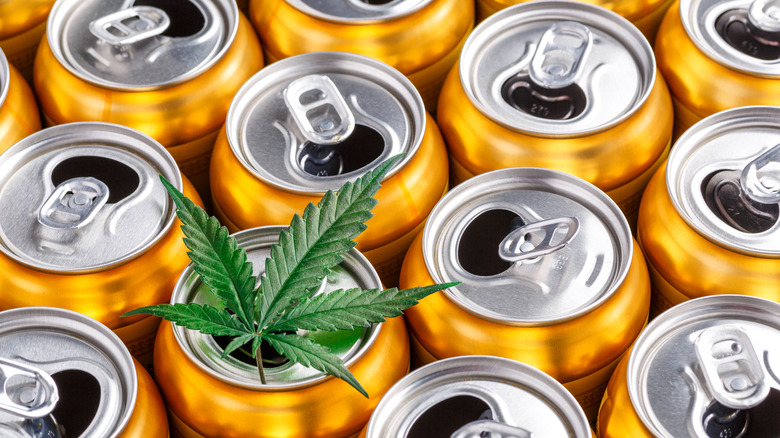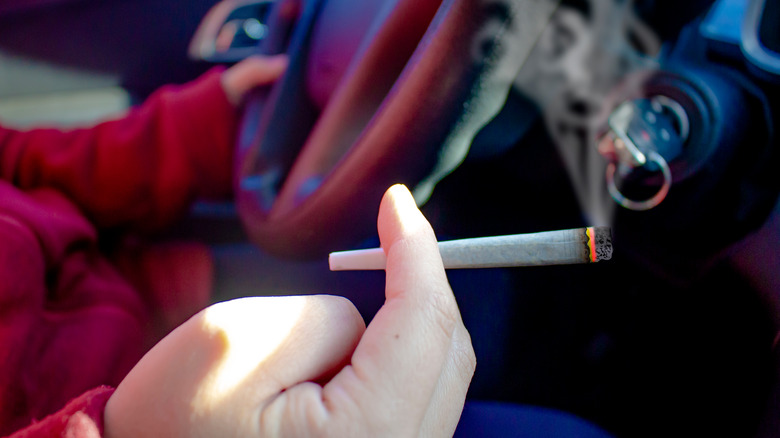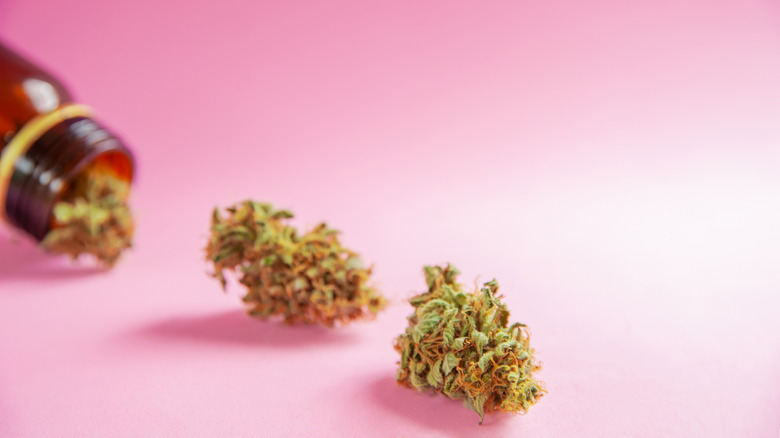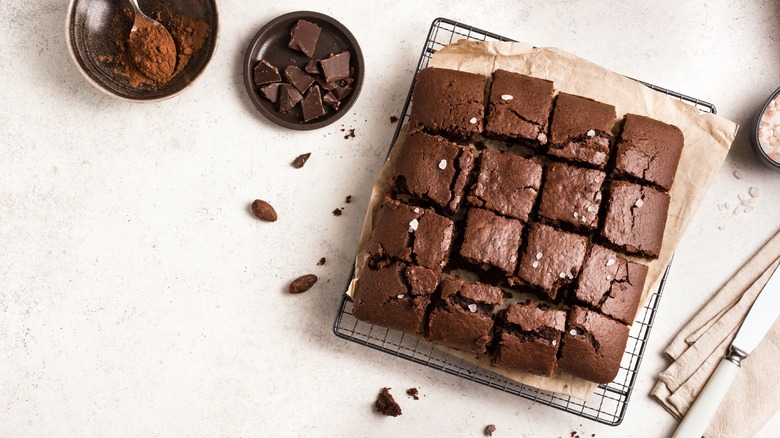15 Things You Need To Know About Cannabis-Infused Food
How much do you know about cannabis?
Recent social and political events have dramatically altered public opinion toward cannabis since the "War on Drugs" and "Just Say No" campaigns of the 1980s and 1990s. According to research by GlobeNewswire, the global edible cannabis market alone is expected to be valued at close to $200 billion by 2030 — which represents an annual growth rate of over 32% since 2021. The market growth has included several factors including the increased number of states legalizing access to recreational and medical cannabis within their respective state lines, as well as increased research and information pointing to the possible psychoactive and health benefits of consuming cannabinoids like THC and CBD. Despite the amount of edible cannabis making its way into the market, there is an ample amount of consumer misinformation about edible cannabis — the good, the bad, and the tasty.
To help walk us through the world of edible cannabis, we spoke to Rachel Burkons, co-founder of Altered Plates and Founder of Smoke Sip Savor.
The two main cannabinoids are THC and CBD
Before we start talking about edibles, we have to talk about the science of cannabis. Marijuana, in its entirety, refers to the dried leaves, flowers, stems, and seeds of the Cannabis sativa or Cannabis indica plant, (via the National Institute of Health). Hemp, which has sprung up as a popular health food in recent years, also comes from the Cannabis sativa plant but contains very low levels of psychoactive cannabinoids — so it won't give you the "high" if it is smoked or eaten, (via Healthline).
There are over 80 different bioactive chemical compounds (cannabinoids) in the marijuana plant, but the most commonly known ones are delta-9-tetrahydrocannabinol (THC) and cannabidiol (CBD). According to BLNCD World, THC activates receptors in the human brain that control appetite, memory, and coordination. It is also the primary agent for the euphoric feeling of smoking, inhaling, or eating cannabis-infused products. BLNCED World notes that CBD can chemically regulate the relationships between the brain's receptors and THC, as well as provide a feeling of relaxation and relieve bodily discomfort.
Cannabis products contain varying levels of THC and CBD, so when choosing a product, you'll want to examine the ratio between the two to find what best suits your needs. High CBD and high THC, as well as balanced mixes of both cannabinoids, can be found in edible cannabis products.
Edible cannabis comes in many forms
There are hundreds of different strains of cannabis strains and potentially as many different ways to consume cannabis in an edible form. According to Verilife, there are two major categories of edibles: those that pass through the gastrointestinal tract, and those that are absorbed sublingually. Marijuana-baked goods, such as the quintessential "weed brownie," often contain cannabis oil and can be purchased at dispensaries in states where recreational or medicinal marijuana is legal. You can also purchase edible chews and gummies with varying levels of CBD and THC in them. If you're a dessert lover, you may also find cannabis chocolate to be the perfect way to end your night.
Cannabis-infused beverages, like seltzers, teas, and mixers, are becoming more popular on the market with the increasing interest in cannabis-infused products. If you like to cook at home, you can purchase cannabis-infused honey, butter (called cannabutter), and oils.
Cannabis edibles can be made with grounds, live resin, or distillate
So how does cannabis actually get into the edible? Depending on the type of edible, the cannabis flower can be ground into a fine powder and added directly into the batter, such as with some recipes for cannabis brownies or cookies. Live resin, which is often known as a "dab," is extracted from a fresh frozen flower that has been heated with butane or propane to extract the cannabinoids; the result is a waxy substance that is sold in vape cartridges or decarboxylating with heat (to make the cannabinoids bioactive) and added to edibles. The distillate is another cannabis product that is already full of bioactive cannabinoids and resembles a runny honey consistency. It can be added to oils, cartridges, or directly into edibles.
Cannabutter is often made with live resin or distillate so that the consistency of the flower doesn't disrupt the butter. This butter can then be used as a base for other culinary applications like gummies, cookies, or savory snacks.
The legality around marijuana and product labeling is a gray area
The legality of cannabis has been a contentious issue. Federally, cannabis products above 0.3% THC are illegal. This means that it is a federal crime to purchase, and ship, "hot" products across state lines. In states where products above 0.3% THC products are legal, including Colorado and Massachusetts, the products cannot cross state lines but can be sold online legally, (via The Island Now).
The labeling and testing of cannabis products is another major issue facing cannabis retailers and consumers. Since cannabis products can include varying doses and servings of THC and CBD, it is important to have a standardized regulation to let consumers know whether consuming a single gummy or the whole pack provides 10 milligrams of THC, notes RTI International. Many cannabis retailers send their products for third-party testing to see how much bioactive cannabinoids are in a product, and this is regarded as the only way to truly know the concentration of cannabinoids in a product, says Elevate Holistics.
The impact of edibles is not felt immediately and can last longer than smoked cannabis products
Eating cannabis-infused food is not the same as smoking a joint. According to the Canadian Centre for Substance Use and Addiction, it will take your body substantially longer to absorb edibles; depending on body weight, metabolism, and tolerance, edibles can take between 30 minutes to two hours to kick in, with a peak high around four hours after eating. The effects of edibles can also last significantly longer than smoked or vaped cannabis, with effects lasting between 12 and 24 hours after consumption. In comparison, smoking cannabis products can cause effects within a few seconds or at an upper limit of around 30 minutes.
The reason for this buffer time is that edibles that pass through the digestive tract must be absorbed by the gut and travel to the bloodstream and brain. Sublingual edibles, such as lollipops and candy, can have a slightly shorter absorption time. If you take CBD oil sublingually, meaning that you leave the lozenge or oil directly under your tongue, the tiny blood vessels in that part of your mouth will more readily absorb the compounds. But, regardless of what type of edible you consume, you should be prepared to clear your schedule — in the chance that the effects don't wear off as soon as you intended.
Inexperienced cannabis users should start with a low-dose cannabis product to assess tolerance
Finding a dosage for edibles can be difficult if you do not have experience purchasing marijuana, or know your tolerance. Rachel Burkons notes that you should start "low and slow" when it comes to dosage, even if you have only smoked marijuana in the past. The starting range is around 2 to 2.5 milligrams of THC; Burkons recommends consuming this small amount and waiting at least an hour and a half before taking any more.
The dose and absorption rate of marijuana are dependent on several biophysical factors. Weight, age, and pre-existing health status or conditions may impact how cannabis is absorbed sublingually or orally. Eating an edible on an empty stomach and the time of day you choose to eat an edible can also impact how the bioactive components are absorbed by the body, so try to have a snack before having an edible.
Edibles are processed by the body differently than smoked marijuana
People often feel more "high" after eating edibles than smoking marijuana. Burkons notes that when THC is absorbed by the digestive tract and through the liver, it is converted to a more potent form called Hydroxy-11 THC. Hydroxy-11 THC combined with the original THC in the product creates a hyper-potent THC experience for the user, (via the Canadian Centre for Substance Abuse and Addiction). When you inhale marijuana products, the THC passes from your lungs to your bloodstream and the brain — thus bypassing the liver. And since it takes a while for the liver to process compounds (think sobering up with alcohol), the effect of the edible is much longer in duration.
Sublingual cannabis products rarely interact with the liver, even if trace amounts are swallowed. Yet, the rapid absorption of the compounds through the blood vessels under the tongue may produce similar effects.
Cannabis beverages are more readily absorbed by the bloodstream
Cannabis beverages are one of the most rapidly expanding parts of the edible industry, Burkons notes. Nano-technology, as science fiction as it sounds, has been a pioneering aspect of drinkable cannabis products because it converts cannabinoids into water-soluble solutions that can be made into products like drinks, condiments, and candies. Ethos Cannabis notes that these nano-emulsions. Essentially, the technology binds cannabis compounds together with the help of pressure, heat, or sound waves. Not only does this make the product more smooth to drink, but it also increases the bioavailability of the cannabinoids like THC. While edibles can take up to one hour to kick in, nano-emulsions can take effect in about 15 minutes.
Ethos Cannabis adds that besides being more readily available, nano-emulsions can provide a higher level of potency than conventional edibles. A 2005 study revealed that nano-particles have a potential absorption of up to 100%.
Pairing cannabis with food is all about finding similarities in flavor
For people unfamiliar with edibles, Burkons recommends exploring how your favorite flavors in food can complement the cannabis you smoke or vape. "Think of cannabis like wine," Burkons says, "just like each wine has its own nuance and profile based on the grapes, cultivation, and production techniques, so does cannabis." While sommeliers try to pair like flavors together with wine and food, finding the perfect combination of cannabis flavors means pairing similar flavor notes between the bud and the food. For example, Burkons recommends pairing a bright strain like Tangie with citrusy food like lemon, orange, or even something dense like chocolate. You can also juxtapose flavors and strains, like minty gelato with vanilla cake or your favorite chocolate chip cookies.
Once you find a good flavor pairing, you can use make your own distillate from the bud or purchase oil from that particular strain to infuse into butter and other recipes.
Cannabis-infused food can give off a different flavor than non-cannabis-infused food
How can you tell if a food has been infused with cannabis? Per Rachel Burkons, it's not easy. You won't be able to detect an organic smell from a brownie made with cannabutter. You may detect a slight difference in flavor between infused and non-infused products if you're using certain cannabis products. If you use a distillate, which does not contain any organic plant material, you won't be able to taste the same organic flavors as using rosin or crusted flower, which contains direct plant material.
After you've become more comfortable finding flavors that complement one another, you can experiment with adding different cannabis products to food. If you're a fan of a sweet, cool treat after dinner, you might consider making a cannabis ice cream with distillate-infused milk. Or, serve an easy French bread with cannabutter at your next adults-only dinner party.
Take special care to store your edibles safely
Since there is little way to tell if a food contains marijuana on aroma alone, it is important to store food tainted with marijuana separately from food that does not contain marijuana. This is especially important if you share a household with children or animals, who may accidentally consume mislabeled cannabis products. According to the Michigan State University College of Veterinary Medicine, THC poisoning can be fatal for domestic animals like cats and dogs and can cause irreversible central nervous system damage — not even including other compounds in the edibles that may also be toxic, like chocolate. Children can also become very sick from consuming edibles.
If you buy prepackaged edibles, WeedMaps recommends storing the product in its original container to prevent confusion. You can also place the edibles into a locked container or on a high shelf to prevent accidental consumption of your adult-only treats.
Cannabis and alcohol can be combined, but with caution
"Cross-fading" is the term used for the melding effects of alcohol and cannabis. Alcohol can boost the absorption of cannabis compounds, per a study published in Clinical Chemistry. Therefore, you should use the "low and slow" mindset when it comes to consuming cannabis and alcohol simultaneously. You should also avoid using too much of any one compound to avoid getting sick; consuming too much alcohol or too high of an edible dose can induce nausea or vomiting on their own, so the impact can be compounded if both are consumed in excess.
Because alcohol and cannabis can both act as depressants, consuming the two in conjunction can lower brain activity — which may manifest as you feeling tired or unmotivated. If you start to feel woozy or tired, you can drink water, relax, and enjoy some carbohydrate-rich food until the feeling wears off.
There are benefits to consuming edibles over smoking
One of the reasons people consume edibles over smoking cannabis is to avoid damage to the lungs and respiratory system. If you have a chronic respiratory illness, or simply don't like the feeling of a smoker's cough, you can try edibles over smoking. Blissed notes that various studies have indicated smoking marijuana has risks including airway inflammation and obstructive pulmonary issues. Other individuals choose edibles over smoking or vaping cannabis for a more discreet experience. You won't have to worry about the smell of cannabis on your clothes and personal belongings.
If you choose to use edibles, GoodRx notes that you have to give up smoking cannabis entirely. You can smoke cannabis at the same time as taking edibles to time the onset of the high, but you may also be prone to overdoing the dose. So, with all things cannabis, always proceed with caution.
CBD edibles provide more of a body high and can lead to relaxation
Another important reason why people consume edibles over smoking is for the "body high" that edibles provide. Some folks who consume edibles have described that the high goes straight to the muscles, which can reduce muscle and joint pain, (via Blissed). For individuals looking for a feeling of relaxation and bodily comfort, we recommend using a CBD and THC hybrid edible or one that is heavier on the CBD end. Combining THC and CBD can reduce some of the complications of eating THC-only edibles — which may include muscle spasms, dry mouth, difficulty sleeping, and paranoia.
According to Greatist, the recommended starting CBD dose is around 25 milligrams. If you're using a full-spectrum product that contains CBD and THC, you should stick to no more than 5 milligrams of THC at a time before titrating your dose to something stronger.
There are right and wrong ways to store edibles
According to Green Rush Packaging, there are numerous ways to store edibles to ensure that the food itself stays fresh and the cannabis remains as potent as it can be. Humidity, sun exposure, heat, and contamination can cause edibles to go bad quicker. To store small amounts of edibles, you can wrap the pieces in parchment paper and store them in an airtight container for a few days. You can also freeze edibles in parchment paper for up to a year — although this process may change the texture of the edible over time. And like storing different types of food, the exact process is dependent on the other ingredients you use.
Airtight containers are the key to ensuring that your food doesn't absorb the flavors of the food stored near it. Depending on the product, this might look like a Mason jar, a plastic bag, or a glass container. You should always be sure to label any food made with cannabis to prevent accidental consumption.
